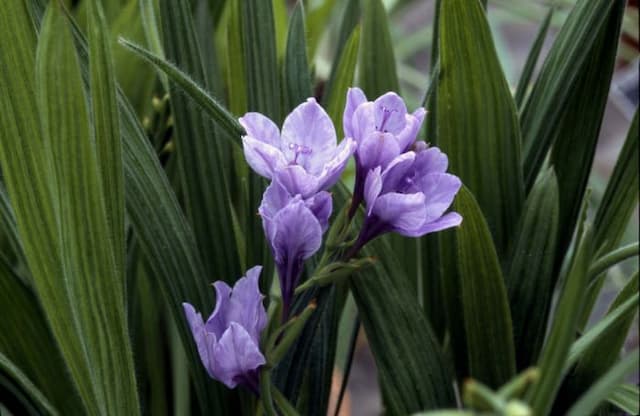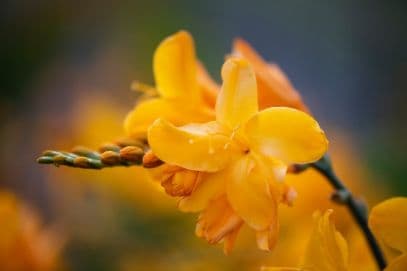Lazic Iris Iris lazica

ABOUT
Iris lazica, commonly known as Lazica iris, is a perennial plant with green, sword-shaped leaves that rise in a dense, clumping manner. The foliage has a slightly arching habit, giving it a graceful and elegant look. The leaves can also have a glossy texture, adding to the visual interest of the plant. The most striking feature of the Lazica iris is its flowers, which usually bloom in the spring. These flowers are typically a shade of blue or violet, but can have some variation ranging from deep purples to lighter blue tones. The petals are often adorned with delicate veining or spotting, giving them a textured appearance that can be quite striking. Each bloom of the Lazica iris consists of three upright petals, called standards, and three downward-curling petals known as falls. The falls usually display a central yellow or white area with a beard-like pattern, which is thought to help attract pollinators. These contrasting features make the flowers stand out against the foliage. In addition, the Lazica iris may have a light to moderate fragrance, which can make it a delightful addition to gardens where scent is appreciated. This fragrance, coupled with the plant's visual appeal, makes it popular amongst gardeners and plant enthusiasts.
About this plant
 Names
NamesFamily
Iridaceae
Synonyms
Lazic Iris
Common names
Iris lazica.
 Toxicity
ToxicityTo humans
The plant commonly known as Lazika iris is not widely reported to be toxic to humans. However, as with many members of the Iris genus, it is advisable to be cautious since irises have compounds that can cause irritation. If ingested, parts of the iris plant can potentially cause symptoms such as stomach upset, nausea, vomiting, and diarrhea. Handling the plant may also cause skin irritation for sensitive individuals. It is always best to avoid ingesting any part of an ornamental plant due to the potential for adverse effects.
To pets
The Lazika iris, like other members of the Iris genus, can be toxic to pets if ingested. Eating parts of the plant, particularly the rhizomes, could lead to symptoms such as gastrointestinal upset, including salivation, vomiting, abdominal pain, and diarrhea. In severe cases, ingestion could result in more serious issues such as lethargy or even liver damage. It's important to keep an eye on pets in areas where the Lazika iris is planted and to prevent them from chewing on the plant.
 Characteristics
CharacteristicsLife cycle
Perennials
Foliage type
Evergreen
Color of leaves
Green
Flower color
Blue
Height
1 foot 4 inches (0.41 meters)
Spread
1 foot (0.30 meters)
Plant type
Bulb
Hardiness zones
7
Native area
Turkey
Benefits
 General Benefits
General Benefits- Aesthetic Appeal: Iris lazica, commonly known as the Lazican iris, adds visual interest to gardens with its striking blue or violet flowers.
- Low Maintenance: This plant is relatively easy to care for once established, requiring minimal attention and upkeep.
- Cold Hardy: The Lazican iris is resistant to cold temperatures, making it suitable for gardens in cooler climates.
- Attracts Wildlife: The vibrant flowers can attract pollinators such as bees and butterflies, supporting local ecosystems.
- Soil Erosion Control: Its root system can help to stabilize soil and prevent erosion in garden settings.
- Seasonal Interest: It provides seasonal interest with its spring blooms and attractive foliage that often remains green in winter.
- Drought Tolerant: Iris lazica can survive in dry conditions, making it a good choice for water-conservative landscapes.
- Decorative Cut Flowers: The flowers can be used in floral arrangements, bringing the beauty of the garden indoors.
- Versatile Planting Options: It can be planted in borders, water garden margins, and rock gardens, offering a variety of landscaping uses.
- Naturalizing: The Lazican iris can spread and naturalize in an appropriate environment, creating larger, more impactful displays over time.
 Medical Properties
Medical PropertiesThis plant is not used for medical purposes.
 Air-purifying Qualities
Air-purifying QualitiesThis plant is not specifically known for air purifying qualities.
 Other Uses
Other Uses- As a natural dye: The roots of the Iris lazica can be used to extract a natural dye for fabrics, though this use is less common compared to some other species of the genus Iris.
- In perfumery: The flowers of the Iris lazica, like some other irises, may be used to provide a delicate fragrance for perfumes, although it is not one of the primary species for this purpose.
- Photographic subject: Due to its striking flowers, Iris lazica is often photographed by garden enthusiasts and nature photographers, adding aesthetic value to photo collections.
- Craft inspiration: The unique shape and color of Iris lazica flowers can inspire designs in crafts such as pottery, glassware, and textile patterns.
- Education: Iris lazica can be used in botanical education to teach about plant taxonomy, propagation, and the Iris family's diversity.
- Eco-tourism: Gardens and preserves that feature Iris lazica can attract visitors interested in seeing this and other plant species in their natural or cultivated habitats.
- Culinary decoration: While typically not eaten, Iris lazica flowers can occasionally be used as an ornamental garnish for culinary dishes, adding a splash of color.
- Traditional customs: In some cultures, Iris lazica flowers may be used in ceremonies or celebrations as a symbol or decoration, reflecting local customs.
- Water garden cultivation: Iris lazica, being a moisture-loving plant, can be used in water garden designs or alongside ponds to create naturalistic landscapes.
- Art inspiration: The elegant form and hues of Iris lazica can be a subject for artists working in various media, including watercolor, oil painting, or digital art.
Interesting Facts
 Feng Shui
Feng ShuiThe Iris is typically used in Feng Shui to attract good Chi, as it is believed to hold energies that can enhance communication and bring creativity. It can be placed in the Creativity & Children area of the Bagua map, which encourages personal growth and the flow of new ideas.
 Zodiac Sign Compitability
Zodiac Sign CompitabilityThe Iris is not used in astrology practice.
 Plant Symbolism
Plant Symbolism- Purity: The iris generally represents purity due to its delicate form and clean appearance, which is often connected to the cleanliness and untouched nature of the flower.
- Hope: Irises often symbolize hope, conveying a sense of anticipation and positive expectation for the future.
- Faith: The three petals of the iris are sometimes thought to represent faith, valor, and wisdom, with faith being a prominent theme.
- Wisdom: Historically, the iris is associated with wisdom and valued for its role in conveying messages of deep knowledge and thought.
- Valor: In some cultures, the iris is a symbol of courage and heraldry, representing the ability to face challenges with bravery.
- Royalty: The elegance and majestic stance of the iris suggest a regal bearing, often linking it to royalty and nobility.
- Messages and Communication: Greek mythology associates the iris with Hermes, the messenger god, and as such, it can bear the symbolic meaning of communication and the sharing of messages.
 Water
WaterIris lazica, commonly known as Lazy Iris, requires consistent moisture and should be watered whenever the top inch of soil feels dry to the touch. In general, this may mean watering approximately once a week, but the frequency can increase during hot, dry periods or decrease during cooler, wet conditions. Aim to provide the Lazy Iris with about one to one and a half gallons of water every week during the growing season, ensuring that the soil remains evenly moist but not waterlogged. In winter, when the plant is dormant, reduce watering to prevent root rot.
 Light
LightLazy Iris thrives best in partial shade to full sun. The ideal spot is one that receives morning sunlight and is shaded during the hottest part of the afternoon. Ensure that the plant gets at least three to four hours of direct sunlight a day, while protecting it from the harsh midday sun, which can scorch the leaves.
 Temperature
TemperatureLazy Iris prefers a temperate climate and can tolerate a range of temperatures, but it grows best when the temperature is between 60 to 75 degrees Fahrenheit. It can withstand minimum winter temperatures down to around 20 degrees Fahrenheit, but in areas with colder winters, the rhizomes should be mulched to prevent freezing. During the summer, it can survive temperatures up to about 90 degrees Fahrenheit, as long as it is well-watered and shaded from the hottest sun.
 Pruning
PruningPruning the Lazy Iris is mainly done to remove spent flowers and tidy up the plant. After blooming, cut back the flower stalks to just above ground level to encourage healthy next year's growth. Pruning can also involve removing any damaged or diseased leaves throughout the season. The best time for major pruning is after the Iris has finished flowering, usually in late spring or early summer.
 Cleaning
CleaningAs needed
 Soil
SoilThe Turkish Iris requires moist, well-draining soil with high organic matter content. A mix of loamy garden soil, peat, and perlite or sand can work well. Aim for a soil pH between 5.5 and 7 for optimal growth.
 Repotting
RepottingTurkish Iris typically does not require frequent repotting and can be repotted every 2 to 3 years to refresh the soil or if the plant has outgrown its pot.
 Humidity & Misting
Humidity & MistingThe Turkish Iris prefers high humidity levels, ideally between 60% and 80%, which mimics its native humid habitats.
 Suitable locations
Suitable locationsIndoor
Provide bright indirect light and keep soil uniformly moist.
Outdoor
Plant in partial shade and moist, rich soil.
Hardiness zone
7-9 USDA.
 Life cycle
Life cycleIris lazica, commonly known as Lazistan iris, begins its life cycle as a seed that germinates in moist soil conditions, ideally in autumn or winter. After germination, the seedling develops a rhizome, which is a horizontal stem that grows underground and serves as the plant's storage organ. In the following spring, leaves emerge along with the signature iris flower, which is typically purple or bluish with a white and yellow patterned area called the falls. The rhizome continues to spread as the plant matures, leading to the growth of more leaves and the development of additional flowering stalks. Once the flowering is complete, the plant sets seeds in a pod-like capsule, which, when mature, opens to release seeds into the surrounding environment. The iris then enters a period of dormancy, typically in the late summer or autumn when the foliage dies back, conserving energy in the rhizome for the next growing season.
 Propogation
PropogationPropogation time
Spring to summer
Iris lazica, commonly known as Lazica iris, can be propagated through division, which is the most popular method for this species. The best time for dividing Lazica iris is in late summer after flowering, when the plant is dormant. To propagate by division, carefully dig up the iris clump and use a sharp knife or spade to separate the rhizomes, ensuring each section has at least one fan of leaves and healthy roots. Replant the divisions promptly, setting the rhizomes so the top is just below the soil surface, spaced about 12 to 24 inches apart (30 to 60 centimeters). Water the newly planted divisions well to help establish a strong root system. This method allows for the rapid increase of plants and helps maintain the health of older clumps by rejuvenating them.









